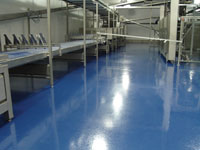
More processors now color-code floors to distinguish areas of operation. Source: Valpsar.
Theno is still sometimes referred to as “the man who saved Jack in the Box” after he traced the 1993 E. coli outbreak to hamburgers that were undercooked by the fast food chain. He uses the sawdust question to illustrate how quickly and radically food processing plants have changed from the ground up-literally. Sawdust, which was the floor-coating of choice for food emporiums and abattoirs dating back to the Middle Ages, is unthinkable as flooring material today, yet only a generation ago, it wasn’t unusual.
Food plant flooring has become an essential element in food safety, worker safety and even sustainable-plant design. And like processing equipment design, work station engineering and best-practices processing, it has undergone a recent revolution in both technology and context.
Yet processors often don’t pay proper attention to floors, taking them more or less for granted. But floors, more than any other structural element in a food plant, must resolve essentially conflicting forces, points out Cheri Droessler, product manager for industrial flooring at Rust-Oleum. “The floor that’s easiest to keep clean and sanitary is a perfectly smooth floor, but they’re impossible to walk on safely. The floor with the best gripping for shoes is a floor that can harbor pathogens and dirt,” she says. “The plant manager’s butt is on the line in these situations. What’s easiest to maintain can be the most difficult to work on.”
.jpg)
Coca-Cola Plant Before: Floor installations often require extensive substrate work, yet must be done quickly to avoid plant downtime. Source: Rust-Oleum.
Flooring material must also stand up to thermal shock: The ambient temperature in a blast freezer can be -30°F or colder, but the cleaning crew hits the floor with jets of hot water steaming at 120°F or above. In some food plants, oils, fats and soaps degrade flooring material, yet top management expects 10 years or more of functional life from a floor that cost several dollars per square foot to install.
Moreover, when new floors are installed in existing plants or old floors are repaired, the work must be done exceedingly fast to minimize downtime. Droessler once worked at a bottling plant where one day’s downtime cost more than $100,000. Yet concrete, cement, epoxy and other materials require long cure times to set and harden properly. Oh, and make sure the substrate surface is perfectly dry-a near-impossibility in many food plants-before topping it with new flooring, or else the new material may buckle or spurge. “The food business is a tricky little industry,” Droessler comments. “Flooring brings all the problems together in one place and makes you face them head on.”
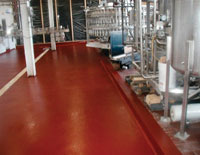
Coca-Cola Plant After: New urethane concrete flooring in a Coca-Cola bottling facility. Source: Rust-Oleum.
“People get tired of fixing and redoing,” notes Keith Kwasny, president of Kwasny-SaniCrete. “They want a floor they don’t have to think about, even with the installations, which have become faster and faster. Customers are demanding 36-hour and 24-hour total installs now. A lot of processors who supply huge chains like Wal-Mart won’t know until a Thursday if they’re going to have to operate on the weekend. That’s when you get the call, late on a Thursday afternoon. ‘Be here this weekend,’ they say. The pressure on the installer, as well as on the performance of the floor, is just tremendous.”
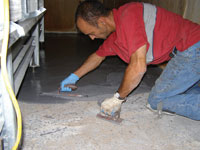
Because of the extreme, fast-changing temperatures in freezing unbaked dough, Garon's Mortarthane HF (trowel-applied) resurfacer is used throughout the concrete floors at Guttenplan Frozen Dough Specialists’ flash freeze dough department. Source: Garon.
The urethane revolution
After the sawdust days waned, brick and tile became the flooring materials of choice in food plants, and both are still widely used. However, 30 years ago, patents were issued in Europe for a new kind of material, urethane concrete, which proved ideal for food plant flooring. In the late 1990s, it began appearing in facilities on this side of the Atlantic. Designed to exhibit a high cross-linking density, cementitious urethane systems are non-toxic, non-hazardous and highly chemical-resistant, and can be installed more efficiently and effectively than older flooring systems.“Urethane cements represent a huge explosion in flooring technology,” says John Crowley, vice president of new business development for Garon Products and president emeritus of International Concrete Repair Institute. “Because of the huge disparity in temperature in a short period of time, urethane mortar flooring is ideal in slaughterhouses, in meat and seafood plants, and for dairy processing, breweries, heavy-duty industrial food processing and even pharmaceutical manufacturing facilities. Floors in these environments are subjected to abuse, heavy traffic, chemical attack and the most hostile conditions out there. Urethane mortars do well in these abusive environments.”
He adds that not every area in a plant requires the functions of urethane concrete; epoxy systems “still rank high on the preferred material selection list, but the trickier and more demanding environments are better suited with a cementitious urethane system.”
Bob Tweedy, a program chemist at Tennant Inc., agrees. “Urethane concrete offers a lot of flexibility. For example, you can formulate a urethane coating to cure at different temperatures, from 20 below to 90 above, which means that the processing plant doesn’t have to change everything in order to have a floor installed. You don’t want to have to empty out your blast freezer, for example, and bring it up to 70
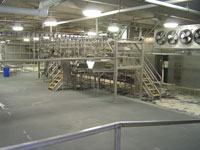
A big advantage to urethane concrete is quick installation time-as fast as 24 hours for a complete install. That’s a significant benefit for plants supplying large-volume customers with short lead times on orders. Source: Kwasny-SaniCrete.
The alternatives
With so many benefits, urethane concrete would seem to be the logical flooring material of choice for any food plant. But it’s expensive, and it’s not the perfect solution to every flooring need. There are also some functional issues: Carbon dioxide trapped in the concrete during the rapid curing process can cause blistering at temperatures above 90A functional tool
Above all, sanitation is the critical issue for flooring in modern food processing plants. Three years ago, a team of processors, plant engineers, architects and operations executives gathered as the Sanitary Facility Design Task Force, organized by the American Meat Institute for the purpose of creating a set of 11 principles for food-safe facility design. Flooring was a central concern and was addressed specifically in most of the principles.“The overall concept is that each sanitary design principle is a hurdle to pathogenic growth,” says Dr. Skip Seward, AMI’s vice president for regulatory affairs and the staff liaison to the task force. David Kramer, vice president of engineering for Sara Lee and a task-force member, adds that the principles “are not intended as design or construction standards, because there is not necessarily one answer. There’s no one best practice when it comes to designing a plant, because design is a creative process. In my organization, we operate by a simple rule: The data must win.”
Taken together, the 11 principles describe a pathogenically “perfect” plant, one that’s ideally sanitary. They recommend establishing distinct hygiene zones for processing operations, and a crucial element in these zones is the control of water accumulation on floors. A pool of water on a floor can be a veritable Jacuzzi of pathogenic bacteria.
The sanitation protocol at Smithfield requires separate cleaning crews for each area of the plant-slaughter, fabrication, further-processing, and ready-to-eat-but the sanitation standards are uniform. However, particular attention is paid to the crucial RTE processing rooms, where Listeria monocytogenes can wreak havoc. Smithfield tests the floor of all its RTE areas for Listeria, which it doesn’t do in other areas of its operations. RTE rooms are held to higher microbial criteria.
Floors, in fact, are become functional tools in the war against pathogens. AgION, for example, has developed an epoxy floor coating with antimicrobial properties-the line includes trowelable floors, top coats, sealants and grout for concrete and brick floors.
Meanwhile, BPI’s Eldon Roth is already testing a radical new kind of floor that, if he installs it throughout his plant, will not only create a new benchmark for cleanliness, it will be the first floor of its kind in any food plant in the world-stainless steel.
“Our plant walls are 3/8-inch stainless steel plates, with an expansion joint every four feet. They’re embedded into the concrete on the outside. They’re integrated right into the wall, in other words. We’re thinking about doing the same thing with our floors, using stainless steel plates.” The advantage? “We will be able to have the ultimate clean-in-place system,” Roth says. “The whole plant will be like a giant dishwasher.”
The floor plates will be coated with a fine grit to create a non-slip surface. Installation is quick and easy, he adds, because the plates can be machine-welded. Seams around drains and gutters are all welded. There will be no cracks or holes for pathogens to crawl into and thrive, Roth claims.
“You’ve got to look at the whole picture,” he says. “Sure, it’ll be expensive at the start. But a giant CIP system is a cost-savings in the long-run, and it does a better job of cleaning and sanitizing. It’s very fast, too. You can turn the whole plant around in a couple of hours.”
Before his career as a food-processing innovator, Roth sold equipment. He says he’s seen unbelievable contamination issues at some operations as the result of poor flooring and walls. Since those days, he’s thought carefully about better ways to address the issues of food safety, worker safety and high-volume processing, beginning at the ground level. “The floor is so critical. For a lot of processors, it’s the last thing they think about, when it should be the first. Everything hits the floor. Everything goes down because of gravity, including all the things you don’t want. You can have the cleanest walls, the cleanest equipment, even the cleanest employees in the world, but if your floor isn’t clean, your plant is filthy.”
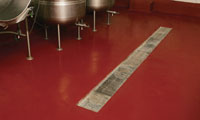
Eco-ProTekt floor coatings meet EPA VOC regulations and contain less solvents than is usual for coatings, which means less evaporation and potential for contamination. Source: Tennant.
Environmental credibility can begin right underfoot
The floor of the food industry’s efforts to create environmentally sensitive and sustainable “green” processing operations is, in fact, flooring.Traditional floors, including epoxy and urethane concrete, often contain high levels of volatile organic compounds (VOCs). Epoxies, especially, often give off polluting odors and residues during installation.
Several flooring suppliers offer alternatives. Rust-Oleum’s line of eight flooring products marketed under the Sierra brand, for example, contains zero VOCs and produces no hazardous air pollutants. The Sierra products recently received Green Seal certification, which makes the products applicable for use in the US Green Building Council’s Leadership in Energy and Environmental Design (LEED) certification program.
According to Emily Popovich, Rust-Oleum’s product manager for water-based coatings, the Sierra floors are best suited for mild-to-moderate environments such as common areas and warehouses. “With any water-based coatings you’re going to have tradeoffs,” she says, “but we think that for processors who are interested in becoming LEED-certified, these coatings offer some great benefits for certain areas of the plant. They don’t do everything, but what they do, they do well.”
Nanotechnology has already been used to a limited degree to embed antimicrobial substances into flooring materials; it may also prove to be effective for green floors as well, creating stronger bonds between substrates and top coats and providing greater elasticity and crack-resistance. “I think nanotechnology could hold a lot of promise for flooring materials,” comments Keith Kwasny. “It all comes down to chemistry.”
Tennant Co.’s four-product line of Eco-ProTekt floor coatings meets EPA VOC regulations and contain less solvents than is usual for coatings, which means less evaporation and potential for contamination. They’re also “virtually odor-free,” according to the manufacturer, and thus can be applied during normal operating hours. The coatings feature extreme thermal stability (-330
Food & Beverage Industry Flooring Suppliers
Atlas Minerals & Chemicals Inc.1227 Valley Rd., P.O. Box 38
Mertztown, PA 19539-0038
610-682-7171; 800-523-8269
sales@atlasmin.com;www.atlasmin.com
BASF Building Systems/Performance Flooring
889 Valley Park Dr.
Shakopee, MN 55379
952-496-6000
www.buildingsystems.basf.com
Blome International/ACSS
1450 Hoff Industrial Dr.
O’Fallon, MO 63366
636-379-9119
info@blome.com;www.blome.com
CornerStone Flooring & Linings
Building A
750 Patrick Place
Brownsburg, IN 46112
800-659-7699
www.cornerstoneflooring.com
Corro-Shield International, Inc.
10548 Lunt Ave.
Rosemont, IL 60018
847-298-7770
info@corroshield.com
www.corroshield.com
Crossfield Products
140 Valley Road
Roselle Park, NJ 07204
800-833-9683; 908-245-2800
www.dexotec.com
Dur-A-Flex Inc.
95 Goodwin St.
East Hartford, CT 06108
860-528-9838; 800-253-3539
info@dur-a-flex.com;www.dur-a-flex.com
FlorLine Group
800 Vista Avenue S.E.
Massillon, OH 44646-7937
330-830-3380
www.florline.com
Garon Products, Inc.
P.O. Box 1924, Wall, NJ 07719-1924
732-223-2500; 800-631-5380
customercare@garonproducts.com
www.garonproducts.com
ITW Polymer Technologies
Manager-Resin Technologies/Composites
PO Box 128, Spencerport, NY 14559
585-349-3225; 585-349-3226
www.itwresintech.com
Kalman Floor Company, Inc.
1202 Bergen Parkway #110
Evergreen, CO 80439
303-674-2290
info@kalmanfloor.com
www.kalmanfloor.com
Kwasny-SaniCrete
24535 Hallwood Ct.
Farmington Hills, MI 48735
248-893-1000
keithk@kwasnyco.com;www.sanicrete.com
Rust-Oleum Corp. Industrial Business Group
11 Hawthorn Pkwy., Vernon Hills, IL 60061
800-769-6565
lmenze@rustoleum.com
www.rustoleum.com/industrial
Sherwin-Williams
101 Prospect Ave.
Cleveland, OH 44115
800-524-5979
sherwin@ultlead.com
www.sherwin-williams.com
Sika Corp.
201 Polito Ave., Lyndhurst, NJ 07071
201-933-8800
sikainfo@sika-corp.com
www.sikacorp.com
SlipNOT® Metal Safety Flooring
2545 Beaufait St., Detroit, MI 48207
1-800-SlipNOT; 800-754-7668
313-923-0400
info@slipnot.com;www.slipnot.com
Stonhard
One Park Ave.
Maple Shade, NJ 08052
800-257-7953 (US)
800-263-3112 (Canada)
www.stonhard.com
Surface Solutions
5689 W. 73rd St., Indianapolis, IN 46278
866-858-4080; 317-388-8000
surface2005@sbcglobal.net
www.surfacesolutionsusa.com
Tennant Co.
701 N. Lilac Dr.
Minneapolis, MN 55422-1452
763-540-1200; 800-553-8033
info@tennantco.com;www.tennantco.com
Valspar
1191 Wheeling Rd., Wheeling, IL 60090
800-637-7793; 847-520-8510
flooringmarketing@valspar.com
www.valspar.com
For a complete list of flooring suppliers,
see Food Master or visit
www.foodmaster.com